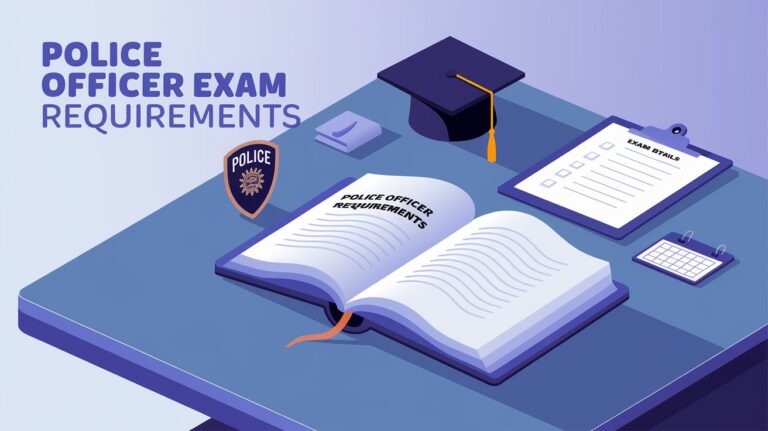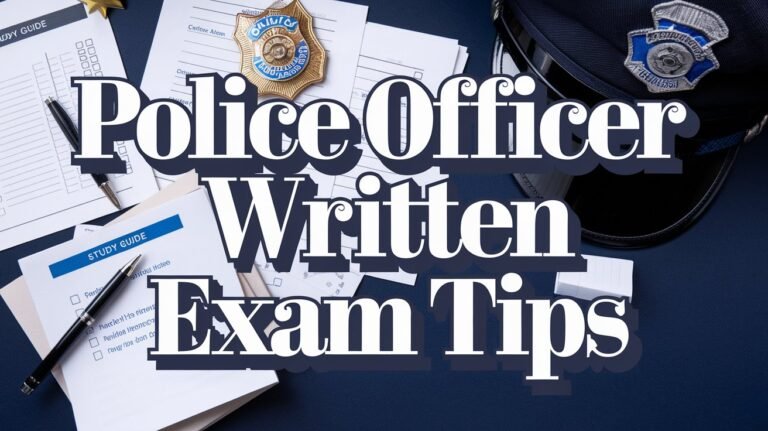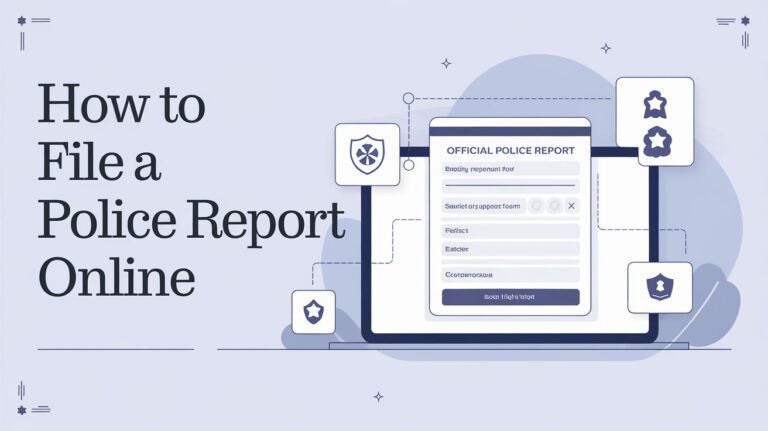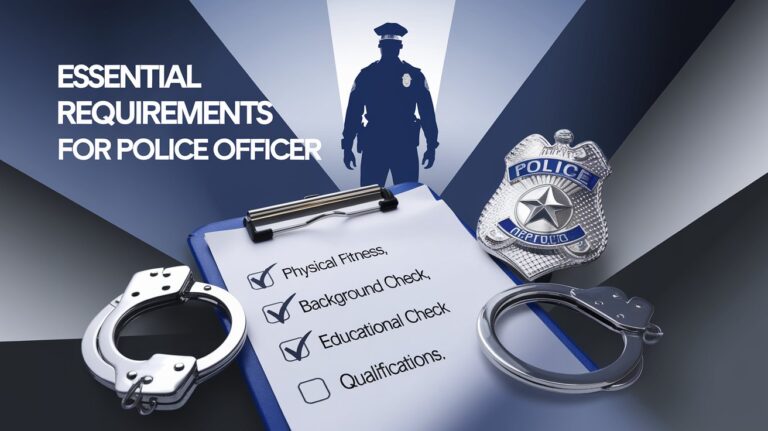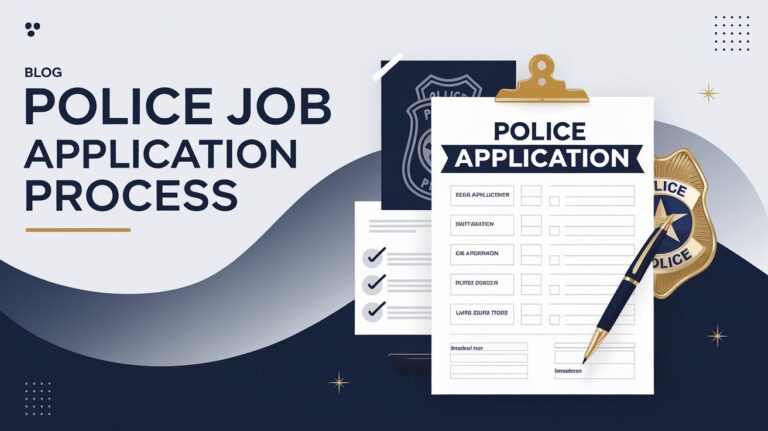Police Academy Fitness Requirements: Achieve Peak Readiness
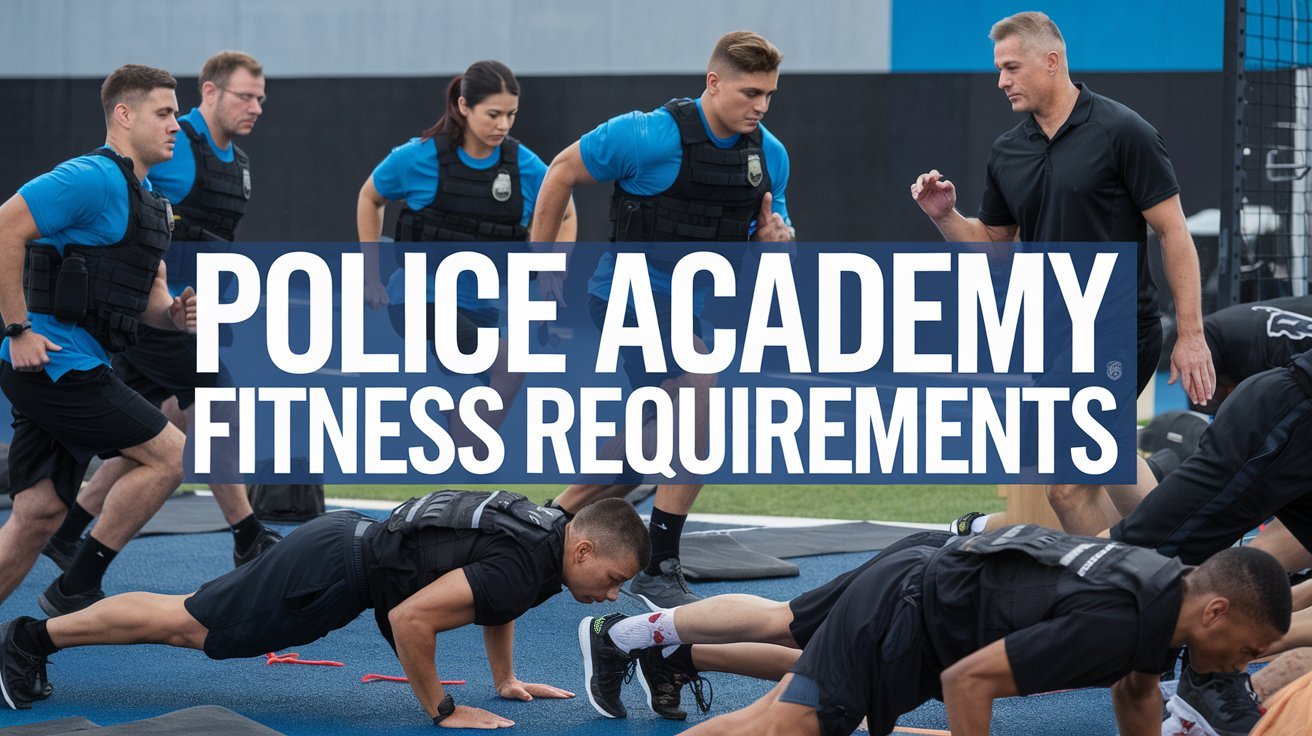
Those wanting to join law enforcement must be ready for tough police academy training. This training tests their endurance, strength, and agility. It pushes them to their limits. Each department has its own set of standards, but common tests include running, push-ups, and sit-ups.
The Houston Police Department’s (HPD) fitness test is a good example. It includes a 1.5-mile run, a 300-meter sprint, push-ups, and a vertical jump. To pass, candidates must not only succeed in these tests but also stay fit during the academy. Getting ready for this test means working on your heart health, building strength, and eating right.
Core Physical Standards and Test Components
Those wanting to join law enforcement must show top physical fitness. The police physical test includes push-ups, sit-ups, and running. These tests check upper body strength, core endurance, and heart health.
Push-Up Requirements and Form
Candidates must do 25 push-ups in a row with the right form. The chest should touch the ground. Different types of push-ups help build strength and endurance.
Sit-Up Standards and Technique
Sit-up standards differ by department. The aim is to do as many sit-ups as you can in one minute. You should interlace your fingers and touch your elbows to your knees.
Running Distance and Time Benchmarks
The test includes a 1.5-mile run to be done in 15 minutes and 54 seconds or less. A 300-meter sprint is also tested, aiming for 78 seconds or quicker. Running regularly and doing interval training can improve these skills.
| Fitness Component | Minimum Requirements | Top Performance Targets |
|---|---|---|
| Push-Ups (1 minute) | 25 continuous | 30-40 for men, 15-25 for women |
| Sit-Ups (1 minute) | Varies by department (e.g., 14 in Dallas) | 35-45 for men, 30-40 for women |
| 1.5-Mile Run | 15:54 minutes or less | 9:44 or faster for men, under 12:30 for women |
| 300-Meter Sprint | 78 seconds or less | N/A |
“To pass the test, individuals need to meet all performance standards without any exceptions, demonstrating proficiency in each component of the physical fitness test.”
Police Academy Fitness Requirements: Department Variations
Police academy fitness standards vary a lot between different law enforcement departments. Each agency has its own set of physical tests and goals. These tests are what aspiring officers must pass to get in and graduate.
The Houston Police Department has its own set of tests. They include a 1.5-mile run, a 300-meter sprint, push-ups, and a vertical jump. On the other hand, the San Antonio Police Department uses a different approach. They score applicants on sit-ups, push-ups, vertical jump, a 1.5-mile run, and a 300-meter sprint.
| Department | Physical Fitness Requirements |
|---|---|
| Houston Police Department | 1.5-mile run, 300-meter sprint, push-ups, vertical jump |
| San Antonio Police Department | Sit-ups, push-ups, vertical jump, 1.5-mile run, 300-meter sprint (scored on a point basis) |
| Dallas Police Department | 14 sit-ups in one minute |
Some departments also consider gender and age in their fitness tests. This is because there are natural physical differences among candidates. Aspiring police officers need to be ready for the specific tests of the department they want to join. These tests are key to making sure they can handle the job’s demands.
Cardiovascular Training Strategies for Academy Success
Aspiring police officers face tough physical fitness tests in the academy. Building a strong heart and lungs is key for doing well. Two main ways to boost fitness are through distance running and sprint/interval training.
Distance Running Programs
Running long distances is a big part of police academy training. Start with short runs and slowly increase the distance. Using an elevation mask can improve lung power, and a weighted vest can strengthen legs.
Sprint and Interval Training Methods
Police recruits also need to do sprint and interval training. Running 300-meter sprints boosts speed and power. It’s important to keep good posture, take small steps, and control breathing during these sessions.
Combining distance running, sprinting, and interval training helps police cadets get fit for the academy. Adding strength training and good nutrition will prepare them for a career in law enforcement.
Upper Body Strength Development for Law Enforcement
Police officers need strong upper bodies to do their jobs well. This strength helps them catch suspects and handle tough situations. To get this strength, they should focus on specific training.
Push-Up Prowess
Push-ups are key for building upper body strength. Start with 100 push-ups a day and increase as you get stronger. Try different types of push-ups to work out different muscles.
Pull-Up Progression
Pull-ups are vital for police work. Start with negative pull-ups to build up your strength. Hold the bar for longer each time to get better.
Grip Strength Exercises
Grip strength is important for police. It helps them use tools and equipment well. Use grip devices, squeeze balls, or dumbbells to improve your grip.
“Developing upper body strength is not just about looking the part; it’s a fundamental requirement for the physical demands of law enforcement work,” explains John Doe, a retired police captain and fitness consultant.
Adding these exercises to their training helps police officers get ready for their jobs. They build the strength and endurance needed to pass the physical test and succeed in their careers.
Pre-Academy Training Timeline and Milestones
Start your police pre-employment fitness early, even when you first apply. Aim for a 70% score on fitness tests, which happen in the police academy’s first week. Early training helps build stamina and strength for the academy.
Weekly Training Schedule
Your weekly plan should mix cardio, strength training, and flexibility exercises. This balance prepares you for the police academy’s challenges. Train 3-4 times a week to stay consistent.
Progress Tracking Methods
- Watch your run times to improve your heart health.
- Count your push-ups and sit-ups to check your strength.
- Notice how long you can keep up with intense activities.
Tracking your progress helps you see what needs work. Celebrate your wins to stay motivated and ready for the police academy.
Nutrition and Hydration Protocol for Candidates
Good nutrition and hydration are key for those aiming to become law enforcement officers. Police cadets need to follow a strict diet to have enough energy and stamina. This is important for their intense training.
Hydration Guidelines
- Drink at least 8 glasses (64 ounces) of water daily.
- Consume water before, during, and after exercise sessions to stay hydrated.
- Avoid sugary drinks, sodas, and caffeine-heavy beverages that can lead to dehydration.
Nutrition Recommendations
- Eat smaller, more frequent meals – aim for 6 times per day.
- Focus on lean proteins, vegetables, fruits, and whole grains.
- Limit processed foods, high-fructose corn syrup, and fatty fast foods.
- Consider following a balanced eating program like the Body for Life plan.
A good daily meal plan for police cadets might include oatmeal with fruit for breakfast. A post-workout protein shake is also good. For lunch, try a tuna wrap. Snack on an apple with peanut butter, and have dinner with lean meat and roasted veggies. This diet helps with energy, endurance, and recovery in law enforcement training.
Common Physical Assessment Elements
Aspiring police officers face tough physical tests to show they’re ready for law enforcement. These tests, known as Physical Ability Tests (PAT), check strength, endurance, and agility. They use standardized exercises to evaluate candidates.
Vertical Jump Testing
The vertical jump test measures explosive power. For example, the Houston Police Department wants candidates to jump 16.5 inches above their height. To get ready, train with box jumps, jump squats, and deadlifts.
Agility Course Requirements
Agility courses are also part of police tests. They test quick changes in direction and balance. To do well, practice cone drills and sprints.
| Physical Ability Test Components | Example Requirements |
|---|---|
| Vertical Jump | 16.5 inches over original height (Houston PD) |
| Agility Course | Timed obstacle course, specific movement patterns |
| Push-Ups | 20 in 90 seconds (Public Safety Testing standards) |
| Sit-Ups | 25 in 90 seconds (Public Safety Testing standards) |
| 1.5-mile Run | 13:46 for males, 16:21 for females aged 21-29 (Chicago PD) |
Police academy tests check if candidates are fit for law enforcement. Knowing these tests and training well can help. This way, aspiring officers can do well in the police physical abilities test and academy physical agility tests.
Recovery and Injury Prevention Strategies
Keeping up with police recruit conditioning is tough. It’s important to focus on recovery and injury prevention. This helps police officers succeed in their training and career.
Warm-Up and Cool-Down Routines
Spending 7-10 minutes on a dynamic warm-up before workouts can lower injury risks. It targets muscles like calves and hamstrings. After intense activities, cool down with static stretches to recover and prevent injuries.
Running Form and Footwear
Good running form is key for police recruits and officers. Run tall and lean forward slightly to avoid shin splints and knee pain. Also, wear quality, fitted running shoes to reduce shock and support your feet.
Strength Training and Nutrition
Strength training, focusing on core and trunk muscles, boosts stability and reduces back injuries. Drinking enough water and eating nutrient-rich foods also improves performance and recovery.
Professional Guidance and Mental Health
Getting advice from healthcare professionals or physical therapists is very helpful. It helps create injury prevention and recovery plans. Also, taking care of mental health and using mindfulness can help deal with law enforcement stress.
Using these strategies, police recruits and officers can stay physically and mentally strong. This prepares them for success in their training and on the job.
Advanced Training Techniques for Elite Performance
Police officers need to stay in top shape to do their jobs well. There are special training methods that can help officers reach the highest levels of fitness.
Elevation Training Masks
Using elevation training masks in your workouts can improve your lung power and breathing. These masks make it harder to breathe, like being at high altitudes. This helps you last longer and use oxygen better during tough activities.
Weighted Vests and Resistance Training
Running with a weighted vest can make you stronger and more endurance. The extra weight makes your muscles work harder. Adding specific resistance training exercises can make your fitness even better.
High-Intensity Interval Training (HIIT)
HIIT is great for getting your heart and muscles in shape. It involves short, intense workouts followed by rest. This method boosts your speed, power, and endurance.
Cross-Training for Versatility
Trying different activities like swimming or cycling can keep your workouts fresh. It also makes you more versatile. Cross-training prepares you for the many tasks police officers face.
Using these advanced training methods, police officers can reach new fitness levels. This ensures they’re ready for the job’s physical demands and perform at their best.
Equipment and Gear Requirements for Training
Getting ready for police academy fitness needs the right gear. Good running shoes are essential for support and cushioning. They help you handle tough training.
Wear comfy workout clothes that wick away moisture. This keeps you moving freely and avoids skin irritation during workouts.
Use a stopwatch or fitness tracker to keep an eye on your progress. An elevation mask simulates high altitudes, pushing your heart. Weighted vests, resistance bands, and a pull-up bar boost upper body strength. A handgrip strengthener improves grip power.
Having the right gear, no matter your fitness level, boosts your training. It helps prevent injuries and prepares you better for police academy fitness tests. Focus on the right equipment to succeed.
Commonly Asked Queries
What are the core physical standards and test components for police academy fitness requirements?
Police academy tests check endurance, strength, and agility. Candidates need to prepare both mentally and physically. These tests usually include running, push-ups, sit-ups, and other tasks.
What are the specific push-up and sit-up requirements for police academy fitness tests?
For push-ups, candidates must do 25 in a row with the chest touching the ground. Sit-ups vary by department but often require as many as possible in one minute.
What are the running distance and time benchmarks for police academy fitness tests?
The 1.5-mile run must be finished in 15:54 minutes or less. A 300-meter sprint should take 78 seconds or less.
How do police academy fitness requirements vary across different departments?
Requirements differ by department. For example, the Houston Police Department tests include a 1.5-mile run and a 300-meter sprint. The San Antonio Police Department tests sit-ups, push-ups, and vertical jumps, along with a 1.5-mile run and 300-meter sprint.
What are some effective cardiovascular training strategies for police academy fitness preparation?
Start with short runs and increase the distance to over 1.5 miles. Interval training with 300-meter sprints boosts performance. Using an elevation mask and a weighted vest also helps build stamina and leg strength.
How can candidates develop upper body strength for police academy fitness tests?
Aim for 100 push-ups daily, starting with your maximum and increasing. Try different push-up variations. For pull-ups, use negatives to slowly lower yourself.
What is the recommended pre-academy training timeline and schedule for candidates?
Start training as soon as you apply. Your weekly routine should include cardio, strength exercises, and flexibility. Track your progress by improving run times, push-up and sit-up counts, and endurance.
What are the important nutrition and hydration protocols for police academy fitness preparation?
Drink 8 glasses of 8 ounces of water daily. Eat lean meats, vegetables, fruits, and whole grains. Avoid processed foods and fatty fast foods.
What are the common physical assessment elements in police academy fitness tests?
Tests may include vertical jumps, agility courses, or specific movements. Prepare with box jumps, quick changes, and cone drills to improve your performance.
What are some advanced training techniques that can help candidates achieve elite performance?
Use elevation masks, weighted vests, resistance bands, and interval training. Cross-training with swimming or cycling can also boost fitness and prevent burnout.


